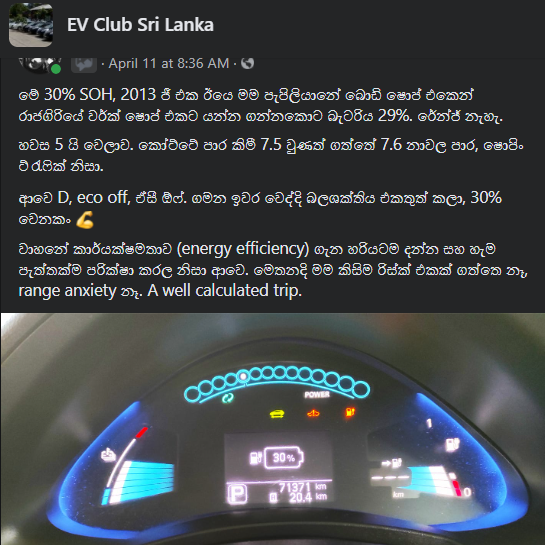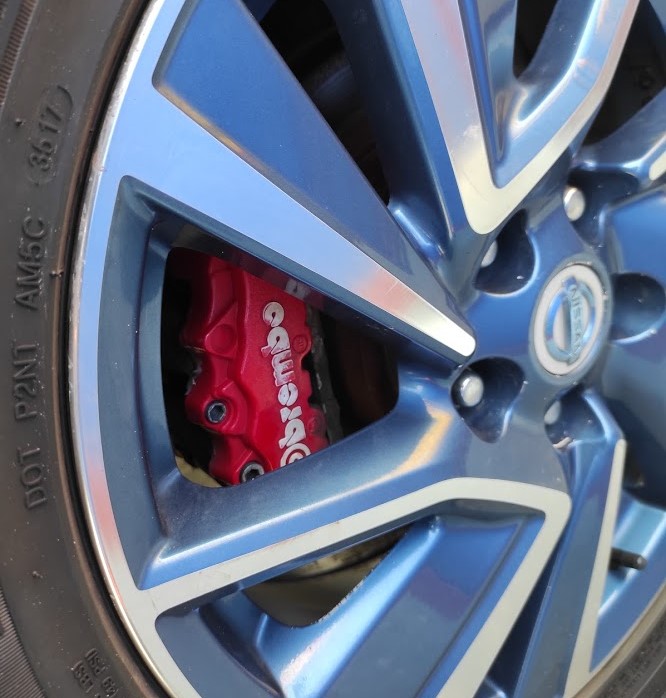Range of an electric car is a prime concern, although the average daily usage is low in most countries. Limited DC fast chargers, ailing traction battery capacilies and battery pricing concerns are yet to resolved . This makes the preserving energy and the range in return invaluble, especially with the low cappacity EVs made prior to 2014.
The author made a public post on making a city trip which ended up with increased energy stored in its battery of a 2013 Nissan Leaf EV. The car had only a 30% SOH, which means only about 6.5 kWh of usable capacity. At the point of start, the available energy (SOC) was 29% which is less than 2 kWh. Technically this will propel the car for about 12 km with traffic and the author finished the trip with an increased SOC of 30%.

This raises some questions especially on the law of thermodynamics. The first law of thermodynamics, also known as Law of Conservation of Energy, states that energy can neither be created nor destroyed; energy can only be transferred or changed from one form to another.
However, this is not a lesson of Physics but sharing the tips and tricks of achieving such. It is needed to highlight that there is an elevation gain. As requested by many followers here we explain the precautions, tips, and tricks everyone can use especially with the low range Generation 1 & 2 Leaf.

There’s no Majic, but there’s conversion of energy with the best use of regenerative braking. Not only there are many other factors you need achieving this feat. However, be cautions as we have been always saying deep discharge is no good for any battery. Ensure that you maintain the best levels of charge at all possible times. Don’t forget shallow charging is the best!
Tips & Tricks
Let’s get to the tips and tricks now. Consider both energy inputs and outputs. Also active and passive points of energy conservation.
Energy efficiency
The energy efficiency of the car is the principal output. Ensure that all your friction points have been carefully examined and serviced. We have explained these points and programs available to audit energy consumption. Compared to ICE, EV s are with much lesser friction points and the energy loss is minimum. Key points are hubs, tires, aligning, brake pads/calipers, compressors, coolant pumps, vipers, and any rotation or moving component. Even 12V batteries need paying attention.
Mobility Alliance has spoken of most above points, mitigation, and correction under the services section and in the home page.
Regenerative braking
Regen effectivity is the prime input whilst on the move. Regenerative braking is a simple concept — use the energy of the vehicle as it slows to create electrical power that can be stored in the vehicle’s battery and then reused.
“Mileage may vary with driver” certainly applies to regenerative braking. At best the conversion of electrical energy into mechanical motion is about 80 per cent. This applies in regenerative braking as well, where converting mechanical motion into electrical energy is about 80 per cent. Mathematically, combining those would give us 80 per cent of 80 per cent which equals about 64 per cent overall efficiency, but it is not that simple. Several factors must be considered: driving terrain (hilly versus flat roads), speed of vehicle when slowing, the mass of the vehicle, the aerodynamic drag and rolling resistance of the vehicle and how the driver decelerates the vehicle.

Almost all hybrid and electric vehicles offer Regen braking. Yet Nissan has perhaps the most sophisticated system on their Leaf EV. Early versions, ZEO/AZEO offer great active displays to monitor the regen effectivity. Moving further ZE1 uses “e-pedal” to launch, accelerate, decelerate and stop the vehicle using only one pedal.
Releasing the accelerator pedal creates a deceleration to a maximum of 0.2 G, which is similar to stepping on the brake pedal. The regenerative braking will bring the vehicle to a complete stop, where the hydraulic brakes are automatically applied to hold the vehicle stopped on a grade. The driver doesn’t have to operate the brake pedal, controlling the vehicle using only the e-pedal. Brake lights are also automatically activated when the e-pedal system is slowing the vehicle.
An average Leaf driver will regenerate 744kWh of energy in about 18,000 kilometers of driving, which is enough energy to light 10,783 houses with 1000 LED lights for five hours, or power 744 television sets for five hours of viewing, or heat 297 electric ovens for one hour to cook supper. The Nissan Leaf doesn’t provide all these “additional” features but this provides an example of how much energy can be generated during braking.
Predictive driving
There are several key points, primarily you need to ensure seeing things beyond. That is to say the operation of traffic lights, traffic ahead, vehicle flow, etc. Stop tailgating, avoid the rush, and many other techniques. Google maps is a great tool to have before you start and whilst on the move, hands-free though. Leaf ZE1 offers android auto, which is a great feature to have.
Be mindful of the terrain and the incline whilst choosing roads.
Easy on throttle and brake
This is common for even ICE. The acceleration and deceleration need to be smooth as possible. Unlike ICE, electric cars offer immediate torque and acceleration so you need not to be a road hogger being a nuisance to others.
Keep light toughing the brake pedal and you will see the amount of regen braking generated with the left dots.
Autonomous controls
EV s are moving fast towards total autonomy, towards self-driving. Even the cars we enjoy today (Leaf to Tesla) have up to level 2 autonomy which includes cruise controls, self-parking, auto braking to lane detection, and lane switching. Some are enjoying even L3 which includes hands-free steering and summon.
However, the human mode still delivers better when it comes to economy and efficiency, in the hands of a good driver. One example is using D and B modes effectively will save over the ECO mode, but be cautious. Driving is an art anyways, so as the economy and efficiency ?
